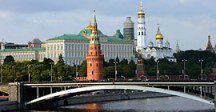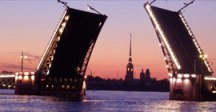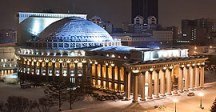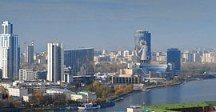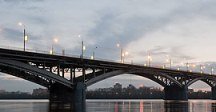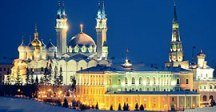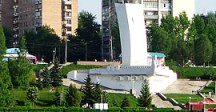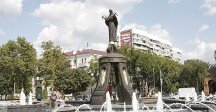Map of Yelabuga
Detailed interactive map of Yelabuga. Map of Yelabuga with streets and numbers of houses. Satellite map of Yelabuga with sights of the city.
The change between the satellite map of Yelabuga and the schematic one is made in the lower left corner of the interactive map.
Yelabuga
The population of the city Yelabuga: 73,962 people (2020)
Date of foundation of the city Yelabuga: 1007
The telephone code of the city Yelabuga: +7 85557
Automobile code of the city Yelabuga: 16, 116
The postal code of the city Yelabuga: 423600
Yelabuga is a settlement in Tatarstan, which is one of the oldest cities in the Republic, I will be famous more than 1000 years ago. Yelabuga celebrated its 1000th anniversary in 2007. It officially became a city only in 1780 by order of Catherine II. At that time, slightly more than a thousand people lived in Yelabuga and there were 4 hundred structures. Today it is home to more than 70 thousand people.
One of the main archaeological attractions of the city is the Ananyinsky burial ground, dating back to the 8th–5th centuries BC. It testifies to the existence of an ancient settlement at this place in the early 11th century. Almost all the buildings of Yelabuga are 19th–century structures that were built after the great fire of 1850. New buildings were built at the expense of merchants and soon made Yelabuga one of the most comfortable towns in Russia.
What to see in Yelabuga
At the corner of Neftyanikov Avenue and Govorova Street there is a small memorial park in memory of the victims of political repression. During the Soviet repressions, more than 700 people from Yelabuga were arrested. The memorial was erected in 2008 and represents a part of the train, the type of which was used to transport prisoners, and pedestals with the names of the victims.
The fountain of the oilman. In the center of the square at the intersection of Mira Avenue and Neftyanikov Avenue, next to the city Palace of Culture, there is an unusual fountain with the image of an oil industry worker. The worker is depicted breaking two stones with his hands, thereby releasing water. The choice of an oilman should symbolize Yelabuga's connection with the oil industry, since an oil production company is based in the city.
Monument to the samovar. The central square of Yelabuga is Khlebnaya Square, where a four-meter statue of a samovar is installed. The monument was unveiled at the Toima Hotel in 2008 and symbolizes both the past of Yelabuga as a city of merchants, as well as the comfort and family warmth associated with the samovar. The area around the monument is also landscaped with flower beds, arches and benches.
Vladimir Bekhterev Museum of Regional Medicine on Neftyanikov Avenue. In 2007, the building of the local Yelabuga hospital, dating from 1881, was turned into a museum dedicated to healthcare in the provincial town of the 18th and 20th centuries. Inside, the interiors of healers' houses, a pharmacy, a consulting room, a modern operating room and an herbal tea room were recreated. The museum also recreated the office of Russian neurologist Vladimir Bekhterev, to whom the museum is dedicated.
In Soviet times, Khlebnaya Square was known as Lenin Square. Since then, the square has regained its old name, but the statue of Vladimir Lenin still stands on the west side between the hotel and the theater. This is the main monument to Lenin in the city, it depicts the leader of the world revolution standing confidently and holding on to the lapel of his jacket.
The Yelabuga ancient settlement, located on a hill overlooking the Kama River near Yelabuga, was first founded in the 10th century by the Volga Bulgars. The settlement included a square citadel with four corner towers to protect trade along the Kama River.
Not far from the Yelabuga ancient settlement there is a modern mosque known as the Zhamiga Cathedral Mosque. The mosque was built in the period from 1992 to 1994 in the traditional Tatar style. The main building of the mosque consists of a one-story structure topped with a green dome and a crescent moon. A 57-meter high minaret has been built on the northwestern side. The complex also includes a guest house and a tea room.
The Museum of the History of the city of Yelabuga was founded in 1980 and since 2007 has been located in a mansion that once belonged to the Nikolaev merchant family. During the move, the museum was completely renovated and interactive elements were added, for which it received several awards. The museum presents exhibits dedicated to the prehistoric era up to the present day. The museum also has a workshop where you can watch how people make traditional souvenirs, and even take part in a master class yourself.
Another unusual monument in Yelabuga is the Monument to communication workers, which is located opposite the main post office of the city. It depicts two life-size statues: one is a postwoman with a bicycle, and the other is a communications worker who is halfway to the pole fixing a lamp. The monument was opened in 2007 to commemorate the 800,000th subscriber of the Tattelecom network.
Near the end of Kazanskaya Street there is a four-meter bronze monument to Dmitry Staheev. Dmitry Staheev was a writer and a prominent representative of the successful Yelabuga merchant dynasty of the Staheevs. The monument was unveiled in 2003 in front of the majestic building of the Yelabuga State Pedagogical University, which itself was originally founded as a Women's diocesan College by another representative of the Staheev dynasty.
Next to Kazanskaya Street is the Pokrovsky Cathedral, built in 1820. The cathedral was built on the site of an earlier church, which was dedicated to St. Elijah the Prophet. Even earlier, there was another Pokrovsky Cathedral, built at the end of the 16th century, but demolished in 1798. Like other churches in Yelabuga, it is made in a classical style.
One of the most unusual museums in Yelabuga and, in fact, Tatarstan is the Laundry Museum, which recreates the laundry created here in the 19th century. The water for the river was piped and heated so that local residents could wash their clothes in one of the most modern laundries for its time. The artist's father Ivan Shishkin was involved in the creation of the laundry.
Marina Tsvetaeva Memorial Complex. At the intersection of Kazanskaya and Malaya Pokrovskaya streets there are three attractions associated with the famous Russian poet Marina Tsvetaeva, who was evacuated to Yelabuga during World War II. Both museums are under the jurisdiction of the Yelabuga State Historical, Architectural and Art Museum-Reserve.
Just behind the statue of Nadezhda Durova is the abandoned Trinity Cemetery. The cemetery served as the final resting place of many merchant families of Yelabuga, including the Shishkins and the Stakheevs, but the more famous grave of Nadezhda Durova is also located here.
The workshop-Museum of Decorative and Applied Arts was opened in 2011 to showcase numerous objects of decorative and applied art stored in the fund of the Yelabuga Museum-Reserve. Exhibits include traditional crafts from all over Russia, such as Gzhel ceramics, Dymkovsky toys and Khokhloma painting. This museum not only demonstrates crafts, but also gives visitors the opportunity to try to make them themselves.
Ivan Shishkin House Museum on Embankment Street. In 1938, the house where the famous Russian artist Ivan Shishkin spent his childhood was turned into the Ivan Shishkin House Museum, which now receives more than 50,000 visitors a year. Shishkin's father, also Ivan, was a merchant in the city, and the museum has preserved the interior of a typical 19th-century merchant's house. Some of the artist's works are on display on the second floor of the museum.
Not far from the Ivan Shishkin House Museum there is a statue of Shishkin, which was opened in 1991 and depicts the artist with a picture frame next to him. Shishkin was born in Yelabuga in 1832 and became mainly associated with realistic paintings of forest scenes. His most popular work is a painting called "Morning in a Pine Forest", which depicts a family of bears.
The main cathedral of Yelabuga is the Spassky Cathedral, which was built between 1808 and 1816. The main building of the cathedral has the shape of a large cube topped with five green domes, to which a 70-meter five-tiered bell tower is attached through an unusually long lobby.
Further down the Embankment Street is the Church of St. Nicholas, which was built at about the same time as the Spassky Cathedral, from 1813 to 1818, in the same classical style. However, unlike the Spassky Cathedral, this church has only one blue central dome, which stands on the rotunda and is smaller in size.
The main war memorial of the city, consisting of several parts, is located on the steps leading to the Yelabuga Millennium Park. The eternal flame is in the center of attention, and along the wall there are pedestals with engraved names of soldiers from Yelabuga who died during World War II. In the upper part of the memorial there are several pieces of military equipment and busts of several war heroes.
The Al-Kamir Mosque is located on a small square in the center of the intersection of Moskovskaya and Gabdulla Tukaya streets. The mosque consists of a simple rectangular structure with a minaret rising from its center. It is located near the Muslim Cemetery at the end of Neftyanikov Avenue. There are three mosques in Yelabuga in total - this one, the large cathedral mosque of Zhamig and, finally, the small Nur mosque next to the museum-estate of Nadezhda Durova.
The only convent in Yelabuga is the Kazan-Boroditsky Convent, dedicated to the Kazan Icon of the Mother of God. The monastery was founded in 1856 as a religious community and received the status of a convent in 1868. The main benefactor at the foundation of the monastery was a local merchant Ivan Staheev.
In 1993, the museum-estate of Nadezhda Durova was opened. Durova disguised herself as a man and enlisted in the Russian army, later participating in the Prussian campaigns and the Napoleonic War. At a later age, she settled in this estate in Yelabuga and began writing memoirs about her life. The museum tells in detail about the life of this wonderful woman, starting from her childhood in Ukraine and a successful army career, to her life in Yelabuga and her literary work, which was highly appreciated.
In the very north of the city, on top of a small hill, there is a cemetery known as the Old Cemetery or Peter and Paul Cemetery. It is easy to see Marina Tsvetaeva's grave here.
The sights of Yelabuga
Alexander City Park, Local History complex, Yelabuga settlement, the Building of Yelabuga University, Kazan Bogoroditsky Monastery, Literary Museum of M. I. Tsvetaeva, Memorial Trinity Cemetery and equestrian monument of N.A.Durova, Memorial House-Museum of I. I. Shishkin, Memorial Complex of Marina Tsvetaeva, Museum "Portomoinya", Museum of County Medicine named after V.M.Bekhtereva, the Museum-estate of N.A. Durova, the Holy Key of Panteleimon the Healer, the Spassky Cathedral, the Church of St. Nicholas the Wonderworker, Shishkin ponds.
The largest cities in Russia:
2024 © Russia-Karta.ru
